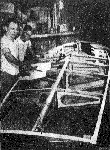 The
last fleet of wooden boats, the Y-Flyer (photo), was built in the
late 50s in a barn on Fisher Road above the lake or in sailor's
garages. By the early 1960s, fiberglass boats were readily available.
The large, national boat manufacturers replaced the local boat builders.
Jim and Jean Shirreff were the first sailboat dealers in Dallas
and gave generously of their time and resources to promote sailing
on White Rock Lake.
The
last fleet of wooden boats, the Y-Flyer (photo), was built in the
late 50s in a barn on Fisher Road above the lake or in sailor's
garages. By the early 1960s, fiberglass boats were readily available.
The large, national boat manufacturers replaced the local boat builders.
Jim and Jean Shirreff were the first sailboat dealers in Dallas
and gave generously of their time and resources to promote sailing
on White Rock Lake.
The Rebel was the first mass produced fiberglass sailboat and was
introduced to the market in 1948. It was also the first fiberglass
one-design sailed on White Rock. Rebel Fleet 24 was organized in
1960 and was the most active fleet in the 1960s and 70s. The Flying
Scot Fleet 23 followed the Rebels in the early 1960s. Both boats
were introduced to the lake in the late 1950s. By the 1980s, there
were over 60 Rebels on the lake and the Scot fleet grew to over
100 boats in the late-90s.
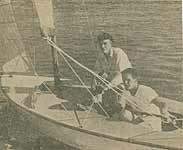 The
Corinthian Sailing Club pays tribute each year to one of the local
wooden boat builders - Maurice Martin. In 1960, Commodore Bednar
donated a trophy for the CSC Champion commemorating Martin who had
died the prior year. He was a charter member of CSC and had built
many of the Snipes and Lightnings on the lake. The 1951 photo shows
Martin and his son in their Lightning. The club
championship was originally conducted as the Maurice Martin
Memorial Handicap Series. In 1966, the format was changed to a regatta
at the end of the racing season to help stimulate greater interest.
It was a weekend of all-out club racing to determine the CSC Champion.
Three races were scheduled on Saturday and two on Sunday.
The
Corinthian Sailing Club pays tribute each year to one of the local
wooden boat builders - Maurice Martin. In 1960, Commodore Bednar
donated a trophy for the CSC Champion commemorating Martin who had
died the prior year. He was a charter member of CSC and had built
many of the Snipes and Lightnings on the lake. The 1951 photo shows
Martin and his son in their Lightning. The club
championship was originally conducted as the Maurice Martin
Memorial Handicap Series. In 1966, the format was changed to a regatta
at the end of the racing season to help stimulate greater interest.
It was a weekend of all-out club racing to determine the CSC Champion.
Three races were scheduled on Saturday and two on Sunday. 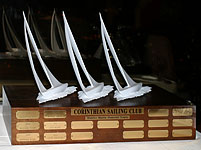 Fleet
champions (one from each fleet) competed against one another in
various fleet boats, changing boats for each race. Non-fleet
contenders were determined by handicap races run along with the
normal fleet races. The championship then changed to a single boat
format. The boat type was rotated year to year. In the mid-1990s,
we started using a Portsmouth handicap allowing each club member
to sail their own boat. The modern version of the Maurice Martin
Championship Trophy is shown right.
Fleet
champions (one from each fleet) competed against one another in
various fleet boats, changing boats for each race. Non-fleet
contenders were determined by handicap races run along with the
normal fleet races. The championship then changed to a single boat
format. The boat type was rotated year to year. In the mid-1990s,
we started using a Portsmouth handicap allowing each club member
to sail their own boat. The modern version of the Maurice Martin
Championship Trophy is shown right.
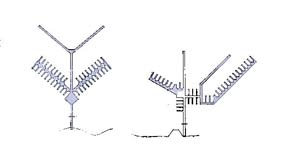 The
1950s and 1960s were a time of expansion. CSC grew to 51 davits and two
piers by 1960 (diagram). The two gates and piers were not joined
and the club was drifting apart into two separate clubs. The two
piers were tied together in 1961 to bring the club back together
under Commodore Willis McQueen. This also provided 18 new davits.
In the 1960s, a total of 89 davits were added to meet the growing
demand.
The
1950s and 1960s were a time of expansion. CSC grew to 51 davits and two
piers by 1960 (diagram). The two gates and piers were not joined
and the club was drifting apart into two separate clubs. The two
piers were tied together in 1961 to bring the club back together
under Commodore Willis McQueen. This also provided 18 new davits.
In the 1960s, a total of 89 davits were added to meet the growing
demand.
The following is a peek into club life during the 1960s based on
anecdotes drawn from the CSC archives.
On club finances -
 The
idea of a disaster fund surfaced in 1962 and dues were increased
so that money could be set aside for the fund. This fund continues
today. (Possibly because of continued flooding - July 1962
photo)
The
idea of a disaster fund surfaced in 1962 and dues were increased
so that money could be set aside for the fund. This fund continues
today. (Possibly because of continued flooding - July 1962
photo)
"The matter of increasing the dues was discussed. It was
felt that we are approaching the saturation point on club membership
and therefore, we would not enjoy the number of initiation fees
we have received in past years during our great growth period.
Dues are now $8.00 per year. It was suggested that the dues be
increased to $10.00 per annum. This was turned down since it was
pointed out that by increasing [dues] to $10.00, we would be subject
to completing the long form Corporation Income Tax Return. It
was agreed to putting the matter to club vote at an annual dues
of $9.75 and the dues were increased in 1964."
On the race program -
A race committee barge with a 9.8 hp motor was purchased - "the
club now has the best judging platform in the area." The
club also received approval from the park department to use a
boat with a motor greater than 10.5 hp "for rescue operations
and race committee work during race days." (1963)
The clubs each used their own permanent marks. Members from all
three clubs "met with City Park Department Supt. Cooke to
advise him of our Race Committee plans for the season. …
The following colors will apply to the indicated clubs: CSC -
red buoy pennants, White Rock Sailing Club - yellow buoy pennants,
White Rock Boat Club - orange buoy pennants." (1963)
"This year there will be no Skipper's meetings prior to
racing. Race Committee will depart from pier one half hour prior
to the first race. All races will begin at 2:30 PM. Race instructions
will be posted on the Race Board." (1963)
"The average race course will approximate one and a half
miles in a triangular course - once around. The committee will
plan to set up two courses: one for Lightnings and Flying Scots;
one for Rebels, Lido-14's, Y-Flyers, etc., due to the fact the
latter boats do not carry spinnakers." (1963)
The first "Annual Awards Banquet" was held following
the "normal racing season." (1963)
CSC held the first "Club Junior Championship" in 1965.
In 1966, a junior race program was started in conjunction with
WRBC.
A "bronze Howitzer starting canon" was purchased. There
is more to come on the canon story. (1966)
The Rebel Nationals were held at White Rock in 1966 (photos below).
We have held a number of other national
events on the lake.
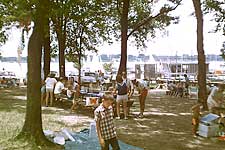
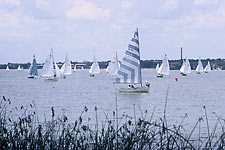
On club facilities -
The club did not have running water until the mid-1960s. Up until
then, bottled drinking water was used. An electric bottled water
cooler was purchased and there was some concern over the use of
20,000 disposable cups in the three summer months. CSC finally
received city approval to bring in city water service. (1963)
"V.C. Cornelison 'brought-up' the matter of Dr. Theodore
Bisland's impounded Rebel. The City Park Department locked his
boat to the davit in 1962 when he failed to pay the annual $7.50
City Lakes License Fee. The boat is full of water and is dragging
down the pier and slip. It was felt something should be done to
rectify the situation plus eliminating the "eyesore"
condition of the boat. It was decided that V.C. Cornelison would
contact the Park Board, to determine whether or not the impounding
is proper in view of the fact that the boat has not been in the
water for two years. An attempt will be made to get the Park Board
to remove the lock and Dr. Bisland is to be advised of the need
to clean up and bail out his boat." (1963)
Members were assessed $10 in 1963 to add a spectator deck over
the existing south pier shelter.
A big flood in the Fall 1964 caused significant damage to the
club. Members were assessed $20 to repair the docks.
The membership had grown to 183 members and the availability
of davits was a big issue. Also, Sunfish sailors were looking
for pads. A proposal to limit membership to 200 was floated and
defeated. (1965)
A facilities expansion program provided 48 new davits and storage for 18 boardboats to
meet the growing membership demands. A center finger for the T-pier
was also added at this time. The T-pier (photo below) was located
where the clubhouse now stands. The wooden davit construction
techniques (drawing below) that were established at this time
were used until steel pilings entered the scene in 2002. (1966)
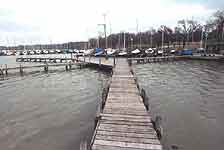
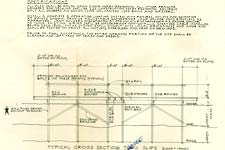
Lake Ray Hubbard was impounded in 1968 providing an excellent sailing
venue close to Dallas. CSC members were instrumental in establishing
Rush Creek Yacht Club, Chandlers Landing Yacht Club and Captain's
Cove in the late 1960s. CSC past-commodore Jim Anderson was a driving
force and founder of the RCYC which was established in 1969 and
whose facilities were completed in 1970. These "expansion clubs"
have enhanced sailing in North Texas.









